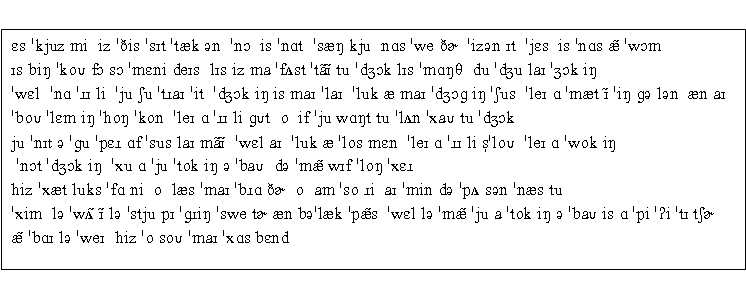Sample passage of Taiwan English transcribed into IPA:

28.
The sounds and allophones of Taiwan English II
(with allophone-writing exercise)
Note: Make sure that you have the Lucida Sans Unicode font installed in your computer so that the IPA symbols will display correctly.
Below is a passage from a local English textbook which has been transcribed into IPA symbols to represent the way it might be read by speakers of 'Taiwan English'. You may laugh when you recognize some of the very typical local pronunciations in it. It is a composite transcription, so it will not be consistent in places; though it is possible for an individual to be inconsistent as well. A few pronunciations (like [suz] for shoes) are typical of Malaysian English, since the transcription was based on readings by all of the students in a phonetics class from a previous year, and a few of these were ethnic Chinese from Malaysia. But mostly it is authentic Taiwan English!
First,
read the text out loud to decipher it, then write it out in regular English
orthography (spelling).
Next, as an exercise, write out ten 'rules' of
Taiwan English, based on the incorrect pronunciations represented in the passage.
If you have other verifiable examples, you may write rules based on those, too;
this passage does not by a long shot cover all the possibilities. After
doing this exercise, one student commented: "I had no idea there were so
many things wrong with our English!" Rather than feeling disheartened,
though, you should feel glad that you will now have a much better understanding
of what constitutes really good pronunciation, and you will be able to put your
finger on just where the problems are. You will then be in a good position to
fix the problems you identify.
Remember
to note errors in both segments (consonants and vowels) and stress
and timing. Although there is a special phonological notation used for
writing allophonic rules (e.g. this rule means that 'obstruents are voiced in
intervocalic position': [- sonorant] → [+ voiced]/V___V), we will write
out the rules in regular prose similar to what we have encountered in chapters
3 and 4 of Ladefoged's A Course in Phonetics. Prose rules are longer
and wordier but easier to understand, and on this page we will try to keep everything
as clear and straightforward as possible. You may look at one or two of the
rules on the next page as a model to get yourself started; but please do your
own work, as well as you can, and don't just copy the rules. You may
find ones not mentioned in the rules on the next page, or your interpretation
of the data may sometimes be different than what is given in the sample rules.
Sample passage of Taiwan English transcribed
into IPA: 
Questions
to think about:
(1) Is Taiwan English a completely non-rhotic dialect? Where is postvocalic
/r/ most often pronounced, and where
is it most often omitted?
(2) What is the distribution of /ɛ/,
/æ/ and /eɪ/
in Taiwan English? Do they occur in free variation? Or are there a few typical
patterns, and individuals tend to follow one or the other of them? What are
these patterns?
(3) Usually a syllable-final nasal 'allophone' has the same backness feature
as the preceding vowel; but the high and mid-high vowels /i/,
/ɪ/, /u/, and /ʊ/
seem to be exceptions in many cases. Can you think why this might be?
(4) Are there any discernible, consistent rules of stress in Taiwan English?
What are they?
(5) Do you think that English orthography (spelling) sometimes leads to incorrect
'spelling' pronunciations in Taiwan English? Do you think these come directly
from the written form of the word, or are they simply transmitted through faulty
teaching? (If you think the incorrect pronunciations come directly from the
spelling, that would suggest that Taiwan English speakers have some knowledge
of English phonics «÷Ūªk, which has not been taught in public schools until quite
recently; you would need to explain this.) Give examples of incorrect spelling
pronunciations in Taiwan English.
After you have done your best to come up with
at least ten allophonic rules of Taiwan
English, you can compare your work to the sample rules on the next page.
Next: The
sounds and allophones of Taiwan English III
(with
sample allophonic rules)
on
to next page
back
index
I index
II
home